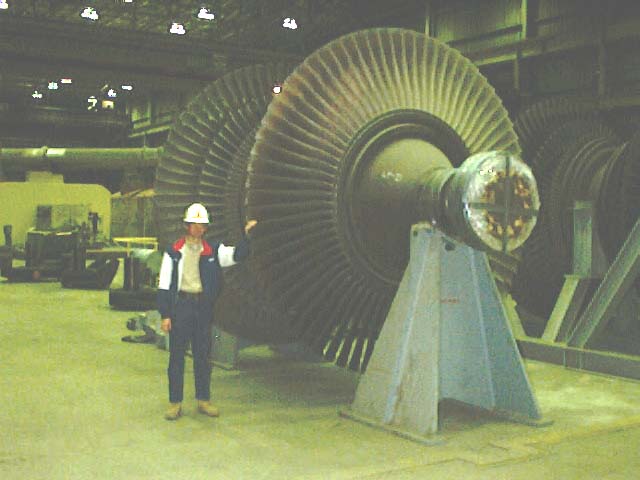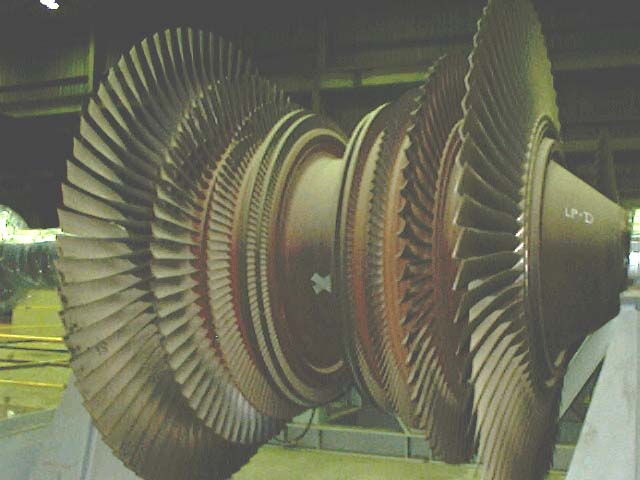
On Saturday, Feb 19, 2000, the IEEE student group organized a tour of the Gavin Power Plant in Cheshire, Ohio. This was a unique opportunity since that quarter we had been using the supercritical reheat cycle as a case study in our thermo course. For everyone who went on the tour it was an awe-inspiring experience. One can only appreciate the enormity of 2.6 GW of power and all that it entails by actually being there. Randy Sheidler (an OU ME alumnus of 1982) was an enthusiastic host and gave us an excellent overview of the plant. With the assistance of Gary Strauch (ME Toledo U) we then toured the plant.
We were fortunate in that they had recently replaced the various Low Pressure Turbine rotors, and the old ones were there on full display. I asked Randy to send us some photographs of rotors so that I could show them on our website and he sent the following photographs. The first picture actually includes Randy so that we can get an appreciation of the impressive size of these turbines. Each of the twin 1.3 GW systems include four of these Low Pressure Turbines. Notice the pitting and distortion shown on some of the large turbine blades in the photographs which is probably the reason for having to replace them. One lives dangerously with these turbines: we would like to get as much power as possible by expanding the steam into the saturated mixture region, however the more water droplets condense out the more prone the large blades are to pitting, ultimately requiring replacement.
I asked Randy to comment on this observation and he indicated that its not as straight forward as that.
"The reason for the turbine change out was due to calculations made concerning the efficiency of the turbines.
"This all began with a problem of the
unit not being able to produce design megawatt output during warm
weather. A problem like this could be caused by any number of
things: condenser tube fouling, sliding pressure valve cage pluggage,
feedwater heater problems, turbine efficiency, internal flow bypassing
turbine stages, cooling tower problems, etc....
Consequently this turned out to be an interesting problem.
"After four weeks of testing and calculations the only conclusion that I could draw was that the turbines were 3-4% below design efficiency. The recommendation that was then presented to management was to change out the turbines. It could also be economically shown that the turbine replacement, although expensive, would pay for itself in just a few years. As it turned out the turbines were found to have worn blading and were found to be bypassing flow internally around stages. The bypassing flow was occurring between the two inner shell halves. They were actually not in poor condition for having been in service since 1984.
"A bit longwinded but that is it in a nutshell." (Randy Sheidler - 3/1/00)
A fascinating account of the responsibilities
of a power plant engineer, and the trust that management places
on their evaluations.


More pictures
______________________________________________________________________________________

Engineering Thermodynamics by
Israel Urieli is licensed under a
Creative Commons Attribution-Noncommercial-Share
Alike 3.0 United States License